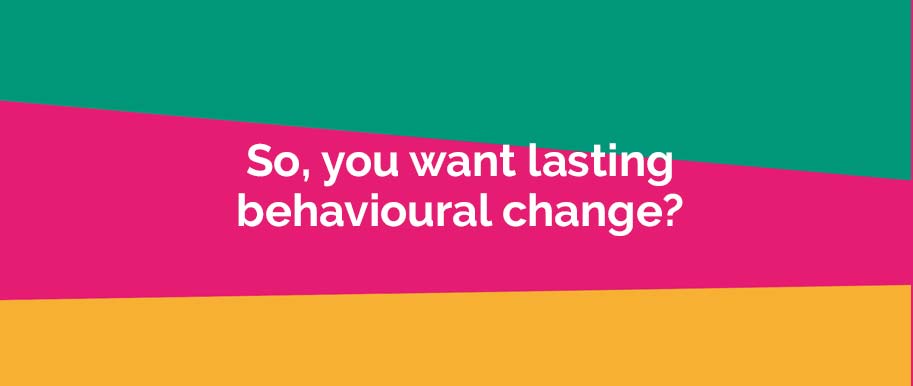With the COVID-19 tsunami upon us, we’re asking ourselves if, perhaps, we can deliver our renowned L&D experience online.
We can’t. Online content can never replace a face-to-face development experience. Watching a video can be part of the experience but can’t generate genuine behavioural change.
Yet, the right online content is a fantastically supportive tool. We frequently use online material to add to the experiences we design and deliver for our clients.
If you’re serious about developing your people and creating new, lasting behaviour, the best way to do so is with in-person interaction. After all, isn’t that what we do every day at work and at home: interact?
The key word is interaction, an intellectual, emotional exchange between two present individuals. If there truly is a way to achieve the same impact with online content, we’re all ears! For now, here’s our take on why face-to-face development delivers behavioural change.
What our experience tells us
There’s nothing wrong with online content. We do offer ‘blended content’ programmes, a mix of face-to-face and online work. The problem is not with online learning in itself; the problem is with the expectation of what it can deliver. In our experience, the online element works very well as a tool to support the face-to-face work. It’s great for recapping learning and solidifying knowledge.
It’s not a replacement. It puts the burden back onto the individual. They watch, listen to or read content in isolation and on their own time. They have to find the motivation to attend and the concentration to stick with it.
While attending a face-to-face workshop, coaching session or development initiative might require an initial expenditure of energy, once you’re there, you’re ready to go. Someone else will take care of the agenda, prompt you to think and encourage you to ask questions. In fact, they’ll create a space for you to do all of the above. All you need to do is focus.
Seeing things from the client’s point of view
Organisations are under pressure – we get it. They’re often faced with a lack of time, demanding work environments and shrinking budgets.
So the appeal of online content that’s easy to disseminate and doesn’t take key staff away from their desks is obvious. It’s probably a much easier sell to the board; it’s safer, tangible, known. The outcomes – a series of numbers churned out by a computer – are easier to monitor. Attendance can be monitored too.
Ahhh, attendance. We’ve seen online programmes with an attendance rate of 5 per cent! That means 5 per cent of the participants have found the time, the will or the inclination to undertake the personal development they’ve been tasked with. For all of the effort of the employer, and the budget stumped up, the payoff is 5 per cent attendance.
While online might seem fast, easy and shareable, the reality is a little different.
Comparison of face-to-face and online learning experiences
Of course we’d say that face-to-face development is better. It’s our bread and butter! Why would we argue for the other side?
Well, comparing the two methods speaks for itself. Remember, the question is not to determine which method is inherently better but to determine which is better at creating genuine behavioural change.
| Face to face | Online |
| Participants can be challenged by facilitators | Facilitator imparts knowledge |
| Facilitator can ask questions of participant – and hear the reply | Facilitator tells participant how it is – they can’t hear replies even if they wanted to |
| Facilitator can hold the participant accountable. They converse | The facilitator reminds the participant of key points. It’s one-directional |
| The participant experiences emotion during human interaction | The experience is cerebral |
| The conversation is a lived interaction – experienced as one half of a dialogue | The experience is a monologue, passively received |
| The face-to-face encounter is unavoidable; people honour commitments | Online content can be ignored, forgotten about and overlooked |
When we participate in an interaction, we form emotional memories. These stay with us and inform our choices and behaviour in future. Online content doesn’t deliver the same experience. The leap from learning to change is that much greater – and unlikely to be achieved.
Don’t take our word for it. Trust our delegates and clients. We frequently receive emails which comment on their experience and how it impacted their work and home life. If that’s not reason enough to convince us that face-to-face development leads to genuine behavioural change… well, we’d better throw in the towel now!
What have your learning and development experiences taught you?
Perhaps we’re missing something. We truly believe that face-to-face contact has to happen for lasting behavioural change to occur. Yet we’re always curious! We’ll keep our minds open to the best ways to achieve behavioural change – and we hope you’ll do the same.
What do you think? We’re intrigued to know your thoughts; contact us to share your take on things. There’s no right or wrong answer and we’re always open to learning something new – teach us a thing or two!
